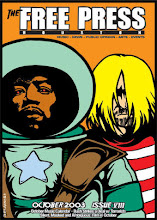Up, up and away
There’s darkness in movies and then there’s darkness in cartoons. The new Pixar movie Up starts out in a somber if not outright devastatingly emotional mode. Speaking to director Pete Docter and producer Jonas Rivera on a recent visit to Houston I mentioned two scenes where the viewer sees blood.
Animated film can encompass everything from Fritz the Cat to Waltz With Bashir to anime but we’re talking about a film distributed by Disney, and the 11th film from Pixar.
Early on in Up we see the lead character, 78-year-old retired balloon salesman Carl whack a construction worker on the head with a mailbox. And there will be blood. “We needed it, you battle certain things with animation. He hits the guy on the head and we’re programmed to laugh, but then he takes his hand away from his forehead and there’s blood,” points out Rivera.
“At Pixar there aren’t that many rules, we can do stuff and if it works for the scene we use it,” says Docter.
“As producer I’m always concerned whether we’ve pushed too far,” comments Rivera. “I looked and for instance, Dory gets a nosebleed in Finding Nemo and that’s what gets the sharks after her. And in Beauty and the Beast he gets stabbed in the back and you see it.
“This is a whimsical world where a house floats away tethered by balloons. We need emotional stakes to make it matter.”
Up also adds talking dogs to the mix. The canines are able to vocalize because their master, a long lost explorer who’s a cross between Prospero and Capt. Nemo has fashioned advanced dog collars that convey the pooches’ thoughts to words.
“The dogs talk but their thoughts betray them. They’re dogs, they tell it like it is,” Rivera notes. Docter adds: “We did things for the dog’s dialogue, like we’d look up a phrase on Google Translate from English to Japanese and then back from Japanese to English to see how we could rearrange the words. ‘Soon the bird shall be ours yet again.’”
Up will open May 29 but not before opening the Cannes Film Festival in a 3D presentation.
“The 3D is basically how much you separate the objects from right to left eye,” describes Docter. “What we tried to do on this movie was to not have too many things reaching out at the viewer. It’s generally distracting.”
Docter emphasizes they’re not calling attention to the 3D so much as using it for the special depth it brings to scenes like the ones that incorporates tepuis (pronounced ta-pooh-ee), a series of unique mesas only found in regions South America. In particular the climax takes place on a tepui modeled after Mount Roraima in Guyana.
When they were location scouting they landed on the top of one tepui and Docter asked the helicopter pilot how many people he thought had been there.
“Thousands?”
“More like 10s.”









0 Comments:
Post a Comment
<< Home